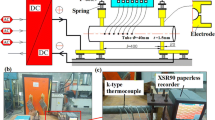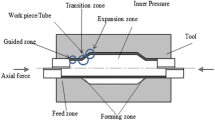Abstract
Tubes with various cross-sectional shapes are widely used in automotive and bicycle manufacture for lightweight considerations. This study proposes a compound forming process for hydroforming a rectangular cross-sectional tube of aluminum alloys AA6061-O. The compound forming process is divided into crushing, hydroforming, and calibration. The finite element simulation software DEFORM was used to analyze the plastic deformation pattern of the tube during the compound forming processes and determine feasible loading paths that can generate a uniform thickness distribution, a lower internal pressure, and a smaller clamping force. The effects of varied internal pressures on the product shapes, thickness distributions, and forming loads are discussed. A self-designed hydroforming test machine with an internal pressure capacity of 30 MPa and axial feeding force of 40 tons was used to conduct hydroforming experiments. The experimental results of the product thickness distributions and dimensions were compared with simulation results, and the validity of the FE modeling is confirmed. Sound products with the required shape and dimensions can be obtained using the proposed hydraulic compound forming process with a low internal pressure of 8 MPa.
Similar content being viewed by others
References
Mason, M (1999) Tube hydroforming using sequenced forming pressures, in: Proceeding of international seminar on recent status & trend of tube hydroforming. Tokyo, Japan, 80–98
Dohmann F, Hartl C (1997) Tube hydroforming: research and practical application. J Mater Proc Technol 71:174–186
Nikhare C, Weiss M, Hodgson PD (2010) Die closing force in low pressure tube hydroforming. J Mater Proc Technol 210:2238–2244
Leu DK (2006) The shaping of a circular tube into a symmetric square-tube by finite-element modeling. J Mater Proc Technol 178:287–296
An H, Green DE, Johrendt J (2012) A hybrid-constrained MOGA and local search method to optimize the load path for tube hydroforming. Int J Adv Manuf Technol 60:1017–1030
Li S, Xu X, Zhang W, Lin Z (2009) Study on the crushing and hydroforming processes of tubes in a trapezoid-sectional die. Int J Adv Manuf Technol 43:67–77
Hwang YM, Chen WC (2003) Analysis and finite element simulation of tube expansion in a rectangular cross-sectional die. Proc Inst Mech Engineer, Part B: J Engng Manufact 217:127–135
Hwang YM, Shr SG, Altan T (2000) Analysis of tube hydroforming in a square cross-sectional die. Int J Engng Simul 1:9–16
Hwang YM, Lin YK (2003) FE-simulations of T-shape tube hydroforming. Key Engng Mater 233:317–322
Hwang YM, Lin YK (2002) Analysis and finite element simulation of the tube bulge hydroforming process. J Mater Proc Technol 125:821–825
Hwang YM, Altan T (2002) Finite element analysis of tube hydroforming processes in a rectangular die. Finite Elem Anal Des 39:1071–1082
Kurokawa H, Kojima M (2002) Hydroforming of tubular parts with rectangular cross section. Advanced Technology of Plasticity Vol. 2:1471–1476
Hwang YM, Huang LS (2005) Friction tests in tube hydroforming. Proc. Instn. Mech. Engrs Part B, J. Engng Manufacture 219:587–594
Hwang YM, Su YH, Chen BJ (2010) Tube hydroforming of magnesium alloys at elevated temperatures. Trans ASME, J Engng Mater Technol 132(031012):1–11
Author information
Authors and Affiliations
Corresponding author
Rights and permissions
About this article
Cite this article
Hwang, YM., Wu, RK. Process and loading path design for hydraulic compound forming of rectangular tubes. Int J Adv Manuf Technol 91, 2135–2142 (2017). https://doi.org/10.1007/s00170-016-9919-z
Received:
Accepted:
Published:
Issue Date:
DOI: https://doi.org/10.1007/s00170-016-9919-z




